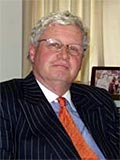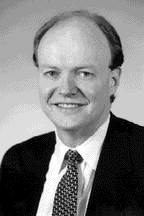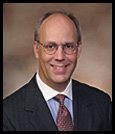Adopted from my 2005-2006
"The Future South Capitol Street Gateway" web site
The "Committee of 100 on the Federal City"
A lack of consciousness of this planning substitution is sadly apparent with groups that could be reasonably expected to promote and protect the monumental green way concept for South Capitol, such as such that display the aerial illustration from 1997 "Extending the Legacy" on their web site's introduction page: the Washington, D.C. based "Committee of 100 on the Federal City" -- web site http://www.committeeof100.net - juxtaposed with their motto:
....to safeguard and advance the fundamental planning, environmental and aesthetic values inherited from the L' Enfant Plan and the McMillan Commission that give Washington its historic distinction, natural beauty and overall livability.
 Illustration from 'Extending the Legacy" adopted for the Committee of 100 web site www.committeeof100.net
Illustration from 'Extending the Legacy" adopted for the Committee of 100 web site www.committeeof100.netBy showing an illustration showing the "Legacy" green way, and by juxtaposing it with a motto referring to the L' Enfant and McMillan plans, the former establishing the Mall, the latter extending it westerly and south easterly, one could reasonably infer that the Committee of 100 endorses this basic concept, particularly in the absence of any published statements to the contrary. Hence, would not such a group express a strong concern about this monumental planning substitution, perhaps some discussion and debate, and report upon it to their members and to the public?
Nonetheless, while their web site does not acknowledge the monumental nature of this planning substitution, it is profuse with praise in the form of awards for those involved with the subsequent planning, including D.C. Office of Planning Director Andrew Altman and D.C. Mayor Anthony Williams, and Joseph Passonneau, of Passonneau and Associates, in Washington, D.C.
http://www.passonneau.com
"for outstanding leadership in planning the Anacostia Waterfront Initiative, to unify waterfront areas with a mix of commercial, residential, recreational, and open space uses."
For Joseph Passonneau they award their "2002 Vision Award" -- juxtaposed with the ariel from "Legacy" -- with the words:
The Committee of 100 on the Federal City takes great pleasure in awarding Joseph Passonneau the first Committee of 100 Vision award for his superb and long standing work as an architect, planner, transportation designer, and publisher in the Nation's Capital.
The first Vision Award was awarded Joseph Passonneau, Committee of 100 member and nationally known architect, planner and writer.
The Award commends unique developments and plans in the District that show sensitivity to communities, preservation of or creative adaptation to historic elements, excellence in design, good use of public space or enhancement of the district's natural features.
May/June 2002 Newsletter, the Committee of 100 on the Federal City PDF
Un-mentioned is the stark difference between Passonneau's vision and that conveyed by the juxtaposed 1997 NCPC illustration.
Whereas the illustration includes a South Capital Street green way extending between Half Streets SW and SE, Passonneau's vision is for a South Capitol Street along its existing 130' row, without the underpass at M Street, (both include massive new real estate development), as indicated by his work as the rendering (at right) that he flashed during slide show/lecture at the National Building Museum in August, 2000.
Committee of 100, why juxtapose Passonneau's name with an illustration of the plan he opposes, rather then one of what he supports?
Passonneau acknowledged his support for major elements of the post 1997 South Capitol related planning when questioned about them during the Q&A period of his March 21, 2005 National Building Museum lecture Washington Through Two Centuries, particularly his position against the 1997 NCPC concept for a South Capitol Street green way, his position favoring constructing massive new real estate development projects before constructing a new tunnel along this corridor.
According to Passonneau, for South Capitol Street, a "green way would wreck the mall". Sidestepping the issue of making infrastructure projects more difficult and expensive by stating that "as an engineer, anything was possible". Possible sure. But how much more difficult and expensive to construct? And with what comparisons of the advantages of some real estate development occurring a few years earlier?
Passonneau has written about the Anacostia Waterfront Initiative and has produced a useful set of drawings showing the historical evolving Washington, D.C., including the National Mall's westward extension and its creation of the Reflecting Pool and the Lincoln Memorial area. He has written articles and books.
Nonetheless, Passonneau's stated stance that a South Capitol Street "green way would wreck the Mall", nor any other such opinion against the Legacy green-way/promenade/esplanade/extension of the National Mall/continuous 3rd Century Mall concept for South Capitol, does not appear in his published writings. [at least those made publically].
Passonneau's book Washington Through Two Centuries: A History in Maps and Images makes only scant reference to the NCPC "Legacy" plan, mainly with a single small scale plan view of the general area at page 277 with regard to its proposed railroad relocation, without even mentioning this planning substitution.
Passonneau's article "A Perspective: History of the South Capitol Street Study Area and How the Study Area Came to Exhibit its Present Conditions" discusses the Anacostia Waterfront Initiative and the focus on South Capitol Street. But it does not even mention, let alone discuss or defend the decision to replace the "Legacy" green way concept with that of yet another urban boulevard, as if the sacrifice of the relatively rare urban opportunity for a monumental green way for the sake of a plan for yet another relatively common urban surface street is too trivial of mention.
The web site of Passonneau's firm, Passonneau and Associates makes no mention of his/their involvement with South Capitol Street related planning. http://www.Passonneau.com
Much like the Committee of 100 of which he is a member, Joseph Passonneau appears to have nothing but words of praise for the Anacostia Waterfront Initiative, D.C. Mayor Williams and Office of Planning Director Altman.
As for the stadium issue, the Committee of 100 web site has two mentions:
The proposed baseball stadium: The Committee was pleased when some sites were taken off the District's list of potential location[s], but there are questions about all three contained in recent meetings with baseball executives. The Committee for several years has espoused moving forward with the acquisition of a baseball team. The Committee has not yet addressed the question of whether outright costs (or the costs of lost opportunities) makes continued advocacy untenable. Newsletter, April/May 2004 at page 4
"...As you may well know, the Committee has been a longstanding proponent of returning the national pastime [baseball] to our home city -- and the nation's capital. We have followed efforts to do so over the past several years, have been a contribute to the public dialogue, and a participant in public meetings leading to the most recent report "Washington, DC Major League Baseball Park Site Evaluation Report..." December 18, 2002 Testimony of the Committee Of 100 On The Federal City At The Joint Roundtable Of The Committees On Economic Development & Finance And Revenue On Major League Baseball In The District Of Columbia, Regarding Potential Stadium Locations And Stadium Financing Options by Jim NathansonThat was the report with 5 sites -- Mt. Vernon Triangle; Capitol North; New York Metro Avenue; RFK stadium north parking lot; and the so-called M Street SE site immediately east of South Capitol Street. This December 18, 2002 Committee of 100 testimony opposed the first 2 options, Mt. Vernon Triangle and Capitol North.
Longstanding planning policy for the Mt Vernon Triangle and all recent studies (there have been several) have called for its redevelopment as a vibrant, mixed use, heavily residential neighborhood. With the exception of a few individuals (mostly staff of the Sports Commission), participants in the planning work and outreach sessions uniformly rejected the notion of a stadium in this location...However for the remaining 3 sites, it states:
Studies have shown that the desired developmental pattern now underway will produce more jobs, about 4 times the net fiscal returns and do far more to support area retail and service establishments than would a stadium. Further, market rate housing and commercial projects are proceeding without subsidy. Assuming the report's projections, the stadium would involve significant lost employment and revenue opportunities when compared with those yielded from currently underway and reasonably anticipated development -- and is likely to require substantial public support. Further, in comparison with other sites, the costs of producing the stadium in this location is far more expensive. A triple whammy.
The report identifies three candidate sites that appear good locations for the stadium. We encourage the city and the Sports Commission, working with prospective ownership groups to immediately perform and present comparative analysis of which of these sites best addresses the goals of the city, prospective ownership groups and Major League Baseball. At this point, we really have very little basis for making comparisons and reaching informed decisions among the remaining sites [emphasis added].How about comparing this 2002 stadium study's "M" Street site immediately east of South Capitol Street's existing 130' right of way, with the significantly widened South Capitol Street featured in the illustration on the Committee of 100's home page?
Less then 6 months later (September 2004) Washington, D.C. authorities announced the contract with MLB to relocate and rename the Montreal Expos as the D.C. Nationals and its selection of the site at South Capitol Street for their new baseball stadium, with the DC City Council to hold a public hearing about this stadium -- the "Ballpark Omnibus Financing and Revenue Act of 2004" Bill 15-1028 -- on October 28, 2004, chaired by Council member Jack Evans (Chairperson of the Committee on Finance and Revenue) and Council member Harold Brazil (Chairperson of the Committee on Economic Development)
Witness list October 28, 2004 Public Hearing; "Ballpark Omnibus Financing and Revenue Act of 2004" Bill 15-1028
http://www.nodctaxesforbaseball.org/witnesslist.pdf
Committee of 100 Membership
http://www.committeeof100.net/about.html
If the Committee of 100 does not object to this stadium site because they favor abandoning the South Capitol monumental green way concept, then where do they state this view openly?
Why do they continue to display the 1997 illustration, juxtaposition it with the Committee of 100 motto, and with Joseph Passonneau and his "Vision" award?
Why not instead show Passonneau's plan?
What about the "Smart Growth" groups; the Sierra Club, and many stadium opponents?
The web sites of other private advocacy groups involved with transportation and or land use planning suggest a general lack of consciousness of the South Capitol green way, as some even praise DCOP AWI, Altman and Williams. The D.C. Metro area Smart Growth Network web site contains nothing anywhere one might expect
http://www.washingtonregion.net/
http://www.smartgrowth.org/
http://www.smartergrowth.net/vision/regions/dc/index.html
http://www.sustainable.org/
The D.C. Sierra Club briefly discusses South Capitol Street without mentioning the significant planning changes:
http://www.dc.sierraclub.org/conservation/trans.htm
---
South Capitol Gateway and Corridor Improvement---
Tom Metcalf, June 5, 2003
The draft study from the South Capitol Gateway and Corridor Improvement Study was released at a press conference today held at the Earth Conservation Corps. The study is available online at:
http://www.publicspace.justicesustainability.com/southcapitol/index.shtml
A related study by the National Capital Planning Commission--The South Capitol Street Urban Design Study--is also available online:
http://www.ncpc.gov/publications/publications.html
Speakers at the press conference included DDOT director Dan Tangherlini, Congresswoman Eleanor Holmes Norton, Congressman Steny Hoyer, and Mayor Anthony Williams. Amidst effusive praise for one another, all expressed their commitment to the transformation of S. Capitol Street into a monumental gateway to the city.
DDOT is accepting public comment on the Draft study for the next 30 days. At the Air Quality & Transportation committee meeting Monday (June 9, 2003) we'll discuss a Sierra Club statement on the study. I also encourage individuals to read the study and submit their own comments.
A few of the findings:
• The Southeast Freeway must be removed for S. Capitol Street to become an urban gateway "worthy of the nation's capital.
• "Creating the Gateway appears not to require the purchase of any private residences"
• The study finds the option of a tunnel (in addition to a new & better bridge) very favorable. In particular, the tunnel would enable the removal of the Southeast Freeway. However, of the 5 bridge replacement options, the "bridge+tunnel" has by far the highest capacity, more than double the current capacity.
Of the abundance of anti-stadium proposal people who testified against the stadium at the D.C. City Council October 28, 2004 Public Hearing, the focus is budgetary - e.g. why not spend the $ instead on schools? This is also true with the anti-stadium group

http://www.nodctaxesforbaseball.org
http://web.archive.org/web/20060715052153/http://www.nodctaxesforbaseball.org/
Latest Testimony and Reports:
NEWS:
NEWS! Council Approves Altered Stadium Deal (Washington Post - 12/15/04)
No DC Taxes for Baseball Statement: Violate the Stadium Deal Because the Deal Violates Us - 12/13/04
News: Opposition Group Makes Final Push (Washington Post, 12/12/04)
Letter (PDF): National Minority Business Coalition Letter to Chairman Cropp on Baseball Agreement - 12/10/04
Press Release (PDF): Catania Warns Against MLB Deal with Angelos - 12/10/04
Radio Ad (Windows Media Player): Listen to the No DC Taxes for Baseball Radio Ad! (12/10/04)
Press Release: Academic Experts Send Open Letter to Chairman Cropp and Other DC Council Members;They Find DC’s Stadium Deal Is One of the Most Lopsided Ever - 12/09/04
Letter (PDF): An Open Letter from Academic Experts on Stadium Deals To Linda Cropp, Chairman District of Columbia Council, And to Other Members of the District Of Columbia Council On the Lopsided Nature of the Proposed DC Baseball Stadium Deal - 12/09/04
Media Advisory: Academic Researchers Find DC's Stadium Deal One of the Most Lopsided Ever - Thursday, December 9 at 11 a.m. 1350 Pennsylvania Ave, NW (Wilson Building), Room 104
News: Strike One. Strike Two. (Washington Post, 12/04/04)
News: Stadium foes hold on to wisdom of Yogi Berra (Washington Times, 12/03/04)
Press Release: Rising Stadium Cost Estimates Is a Serious Issue, Says No DC Taxes for Baseball Campaign, Mayor William and Council Stadium Supporters Should Not Dismiss This Problem - 12/6/04
News: Stadium Analyses Put Cost Far Higher (Washington Post, 11/13/04)
Stop the Stadium Poster! Download as a PDF or JPG. You can also email Chris Weiss to request hard copies.
WHO WE ARE:The DC area is the largest metro area without a team and one of the wealthiest in the nation. Major League Baseball should be begging to come here rather than making outrageous demands. The District is struggling to meet basic needs -- in environmental protection, education, libraries, health care, and other areas. It should not put in a baseball stadium before other investments that could do a lot more to improve the quality of life for DC residents and businesses.
We are DC residents and organizations who oppose taxpayer financing of a new baseball stadium. We believe that DC should use its limited resources for things that really matter - such as schools, healthcare, public safety, the environment, and basic city services. We believe that a stadium should be built by the people who stand to profit - the team owners - not DC taxpayers. And we demand an open process, complete with public hearings, on the issues of stadium financing and site selection.
BACKGROUND:
Most DC area residents would love to have a baseball team to call their own. But Mayor Williams' plan to spend $383 million to build a baseball stadium is a bad deal for the city. Research from university scholars--- as opposed to biased studies commissioned by baseball "public financing" proponents --- shows that a team would create mostly low-paying, low benefit, part-time jobs and would not strengthen the local economy. Even the most successful stadiums, such as Baltimore's Camden Yards, fail to produce enough tax revenue to justify large public subsidies. The well-off owners of Major League Baseball have told the cash-strapped District that the city must pay most of the cost of the new stadium. This is not fair, and it doesn't even make economic sense.
Contact: NO DC Taxes for Baseball! Campaign, c/o Friends of the Earth,
1717 Massachusetts Ave., NW, Suite 600,
Washington, DC 20036 -
202-783-7400 (phone), 202-783-0444 (fax), cweiss@foe.org
COALITION MEMBERS:
(Partial List)
21st Century School Fund
Campaign for the DC School Budget
Council of Latino Agencies
DC Action for Children
DC Black Church Initiative
DC Fiscal Policy Institute
DC Library Renaissance Project
Empower DC
Friends of the Earth
League of Fans
League of Women Voters of the District of Columbia
Legal Aid Society of the District of Columbia
Manna Inc
National Association of Minority Contractors, DC Office
Neighbors Consejo
Parents for DC Public Schools
Save DC Parks and Play Spaces
Statehood Green Party
Washington Legal Clunic for the Homeless
Washington Regional Network for Liveable Communities
Wider Opportunities for Women

Little or nothing is said about infrastructure, let alone the blocking of the green way. Out of 100+ speakers, only 2 brought up stadium-related infrastructure issues: Janet Brown from the Washington Regional Network (listed as "Resident"), who mentioned the proposed replacement bridge (but not the Legacy green way nor the AWI tunnel); and www.HighwaysAndCommunities.com founder Douglas Willinger, the only speaker to bring up the stadium site's conflicts with the Legacy South green way and how it may complicate the AWI tunnel in the relatively soft soil conditions that would likely make such tunnel construction more difficult and expensive. See testimony.
This later point was explicitly acknowledged by the response of D.C. Council member Carol Schwartz (R)
http://cos-mobile.blogspot.com/2008/07/jesuitical-new-medievalistneo-feudalist.html





























